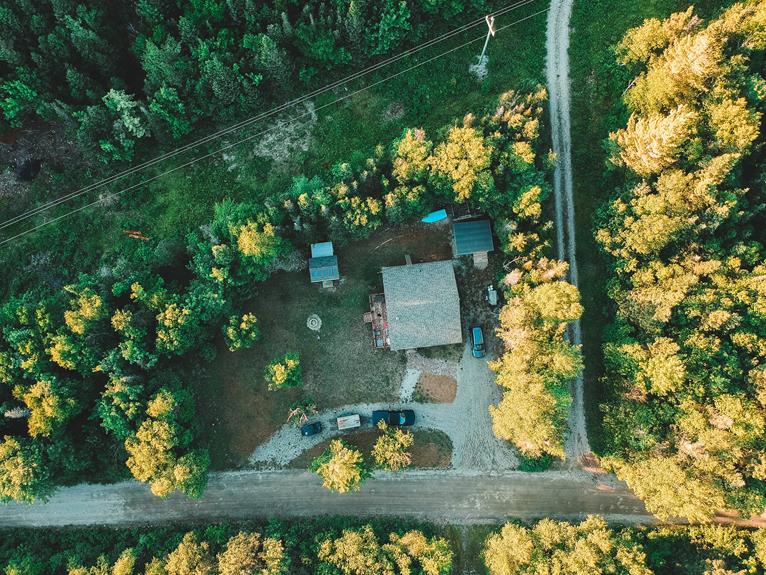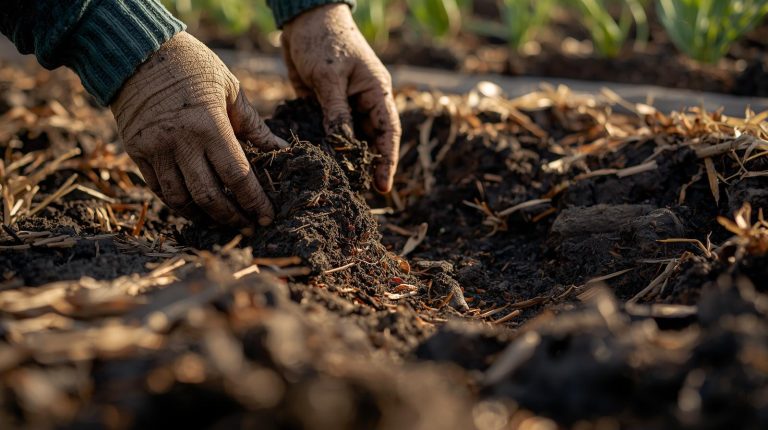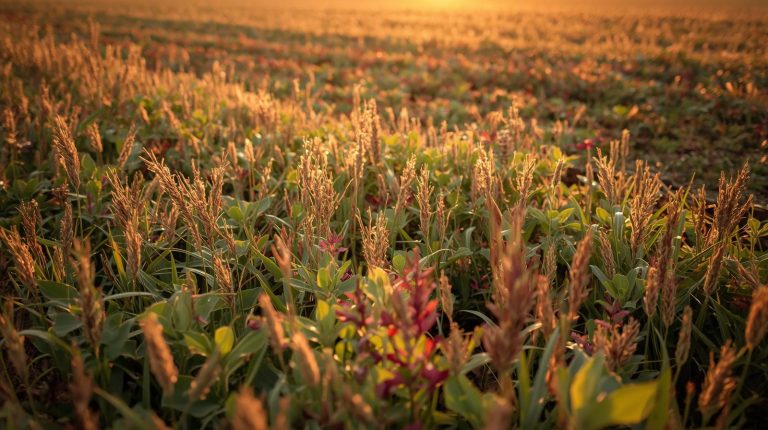As you weave the tapestry of your outdoor space, consider the threads of sustainability that can create an eco-friendly masterpiece. You’re part of a community that values the earth, and by integrating these nine best green landscaping ideas, you’ll nurture your yard while caring for the planet.
Embrace native plants that thrive with minimal fuss, capture rainwater’s bounty to nourish your garden, and enrich the soil with organic mulches. Explore lawn alternatives that save water and invite wildlife into your green haven.
By choosing drought-resistant flora, employing natural pest control, and lighting your evenings with solar energy, you’ll craft a landscape that’s not only beautiful but also kind to Mother Nature.
Together, let’s cultivate spaces where nature and neighborhood flourish side by side.
Native Plant Selection
Selecting native plants for your yard ensures a low-maintenance landscape that’s in harmony with the local ecosystem. When you choose plants and trees that are native, you’re embracing an innovative approach to landscape design. It’s about more than beauty; it’s about fostering a sense of belonging with the environment around you.
By understanding the water requirements together with the soil preferences of your local flora, you can create an eco-conscious space that thrives naturally.
Incorporate a rain garden featuring native grasses and groundcovers to manage water sustainably while supporting local wildlife. Native trees and plants offer an environmentally friendly backbone to your garden, connecting you to your ecological roots. Your yard becomes a testament to a holistic lifestyle, celebrating the symbiotic relationship between you and the local landscape.
Rainwater Harvesting Systems
As you seek to redefine your yard’s harmony with nature, consider the transformative potential of rainwater harvesting systems.
Setting up a rain barrel or installing a cistern can capture precious rainwater during storms, which you can then channel to nourish your garden.
Water Collection Methods
You can collect up to 60 gallons of water per rainfall using a rainwater harvesting system, an efficient way to reduce your outdoor water consumption. By embracing this practice, you’re joining a community dedicated to conserving water and nurturing our Earth.
Your rain barrel becomes a reservoir, capturing stormwater runoff from roofs before it can carry pollutants into waterways. Harvested rainwater is used to quench your garden, minimizing the need for tap water. Integrating a drip irrigation system, you ensure every drop is purposefully directed to plant roots, drastically reducing the amount of water usually lost to evaporation.
That captured water is an excellent conserve-but-prepare strategy: in low-lying yards or after heavy storms, you also need a plan to move excess away from foundations and landscape beds. Combining rain barrels, rain gardens, and permeable paving with properly sized drainage and targeted sump pump installation helps prevent standing water and protects structures. A site assessment can reveal natural collection points and the best places to route flows so systems complement each other. When integrated thoughtfully, these measures reduce maintenance while keeping your eco-haven functional and resilient.
This holistic approach not only conserves water but also fosters a deeper connection between you, your garden, and the environment.
System Installation Tips
Ensure your rainwater harvesting system is optimally placed by situating rain barrels or cisterns directly beneath downspouts to maximize water capture. To nurture your eco-haven:
- Integrate a green roof to absorb rainwater and regulate soil moisture, lessening the load on your rain barrels.
- Use organic mulch around plants to conserve collected water and foster deep root growth.
- Implement Integrated Pest Management (IPM) to minimize the need for water-polluting chemicals.
Embrace these steps to create a symbiotic relationship with nature. Your garden, with its vibrant ground cover and the hum of life around the compost bin, becomes a testament to your dedication.
Together, we can tread lightly on Earth, building a community where every drop of rain is a step towards sustainability.
Organic Mulching Techniques
Organic mulching techniques offer you a straightforward way to nurture your garden while conserving water and fighting weeds. By layering natural mulch, you’re not just covering the earth; you’re embracing a living, breathing ecosystem in your own backyard.
This blanket of organic matter, whether it’s compost, leaf litter, or grass clippings, enriches the soil, inviting a symphony of life that supports growth and vitality.
Using mulch helps to reduce soil compaction and prevent soil erosion, ensuring that every drop of rain nourishes rather than washes away your efforts. As garden waste transforms into fertilizer, it feeds your plants, reducing the need for chemical alternatives. However, this type of technique requires consistent maintenance and can be expensive. In this case, you can choose landscaping with rocks and boulders to avoid yearly maintenance.
You’re part of a cycle that honors the earth, fostering a sense of belonging with every handful of mulch spread.
Eco-Friendly Lawn Alternatives
Shifting from traditional turf to eco-friendly lawn alternatives can further reduce your yard’s environmental footprint and maintenance needs. You’ll not only reduce water usage but also foster a sense of belonging with the local ecosystem.
Here are a few ways to transform your space:
- Ground Cover Instead: Choose low-maintenance options like moss or clover, which don’t require frequent mowing.
- Native Plants: Incorporate these into your landscaping to promote natural pest control and minimize the need for chemical interventions.
- Organic Practices: Utilize organic fertilizer, compost, and organic matter to enrich the soil naturally.
Drought-Tolerant Landscaping
You’ll find that incorporating drought-tolerant landscaping is a seamless next step in crafting an eco-friendly yard. Embrace water-saving xeriscaping principles, where ground cover hugs the earth, requiring little water and thriving in your region’s climate.
By choosing native plants, you’re not only conserving water but also providing a sanctuary for local wildlife.
In your eco-conscious haven, consider installing rain gardens that capture stormwater runoff, bolstering your yard’s resilience. Use permeable paving and decomposed granite for walkways to ensure the ground absorbs rainwater, minimizing wasteful runoff. Every drop saved counts toward a greener tomorrow.
With these methods, you cultivate a space where you belong to a community of stewards, nurturing the planet one yard at a time.
Natural Pest Control Solutions
You’re not just landscaping; you’re stewarding a living ecosystem right in your backyard. Embrace the role of nature’s ally by integrating beneficial insects that keep pests in check, sustaining your garden’s health organically.
Swap out harsh chemicals for organic pesticides, and you’ll safeguard your slice of the environment while nurturing the buzz of a vibrant, eco-friendly yard.
Beneficial Insects Integration
Incorporating beneficial insects into your yard’s ecosystem is an effective way to naturally keep pests at bay. By attracting beneficial insects, you’re enlisting nature’s own pest management team. These tiny allies work harmoniously within your garden, maintaining balance and deterring unwanted critters.
Here’s how you can invite these eco-heroes:
- Plant native species that bloom at various times to provide a continuous food source.
- Leave grapefruit halves around as a sweet treat to lure pest-eating friends.
- Introduce milky spore bacteria to gobble up lawn grubs.
Utilizing natural insecticides like insecticidal soaps and oil sprays can be a gentle nudge, yet it’s the beneficial insects integration within Integrated Pest Management (IPM) controls that truly embodies a sustainable, community-centric garden.
Welcome these small saviors and watch your green space thrive.
Organic Pesticides Use
While attracting beneficial insects is a key strategy for natural pest control, you can also incorporate organic pesticides as a safe and effective complement to these efforts. Embracing Integrated Pest Management (IPM) means you’re choosing a holistic approach that controls unwanted pests without resorting to harsh chemical fertilizers.
Consider oil sprays for mites, which are kinder on the ecosystem and reduce the amount of water pollution. By planting native plants that are naturally resistant to local pests, you’re crafting a community in your yard that stands resilient, minimizing the need for fertilizers and herbicides.
Your commitment to organic pesticides use reflects an environmentally friendly ethos, ensuring your green oasis flourishes in harmony with nature’s rhythm. You’re not just cultivating plants; you’re nurturing a sense of belonging to the Earth.
Solar-Powered Outdoor Lighting
Harnessing the power of the sun, solar-powered outdoor lighting offers you an efficient way to illuminate your yard sustainably. These eco-conscious fixtures are a cornerstone of green landscaping ideas, turning your garden into a haven that not only looks magical at night but also aligns with your values of stewardship for the planet.
- Energy-Efficient: Solar lights convert sunlight into electricity, which means your outdoor lighting uses a lot less energy from non-renewable sources.
- Sustainable Design: With no need for electrical wiring, these lights support a sustainable landscape that nurtures the environment.
- Security and Aesthetics: Motion-sensor options provide safety, while the ambient glow enhances the beauty of your eco-friendly yard.
As you explore Landscaping Ideas, remember that solar-powered outdoor lighting is a step towards a harmonious and sustainable future.
Wildlife-Friendly Habitats
As you consider the enchantment of solar-lit evenings, don’t forget that creating wildlife-friendly habitats in your yard can also bring a lively daytime symphony of nature’s best.
By choosing native plants, you’re opting for sustainable landscaping that resonates with the local ecosystem. These plants thrive without the crutch of fertilizers or pesticides, safeguarding your eco-friendly yard from harmful chemicals.
Incorporate a variety of shrubs and trees, especially deciduous ones, to provide shelter and nourishment for different species. Consider installing a living wall or arranging garden beds to create vertical diversity. This not only adds aesthetic value but also fortifies your haven against local pests and disease.
Embrace the holistic approach of wildlife-friendly habitats, where every choice fosters a sense of belonging within the natural world.
Composting for Soil Health
Before diving into the specifics of creating your compost pile, it’s important to understand how composting benefits your soil’s health directly.
When you install a compost bin, you’re providing a dedicated space where household and garden waste, including fruit and vegetable scraps, can transform into nutritious compost ready to enrich your garden.
- Soil Revitalization: Instead of letting garden waste contribute to soil compaction, add compost to improve soil structure and aeration.
- Nutrient-Rich: Compost infuses the soil with vital nutrients, reducing the need for chemical fertilizers.
- Natural Recycling: Turn everyday waste into an asset for your yard and community, fostering a sense of eco-responsibility and connection.
Once your compost is ready for use, you’ll feel the pride of nurturing your little patch of Earth holistically.
Conclusion
You’ve explored the harmony of green landscaping, now it’s your hands that hold the power to transform. Imagine the ripple effect as your yard becomes an eco-haven. Will you step into this living art, nurturing your slice of Earth?
It’s more than beauty; it’s a legacy. Embrace this change, for every seed sown whispers a promise to the future. The question isn’t if you can make a difference—it’s when will you start?




